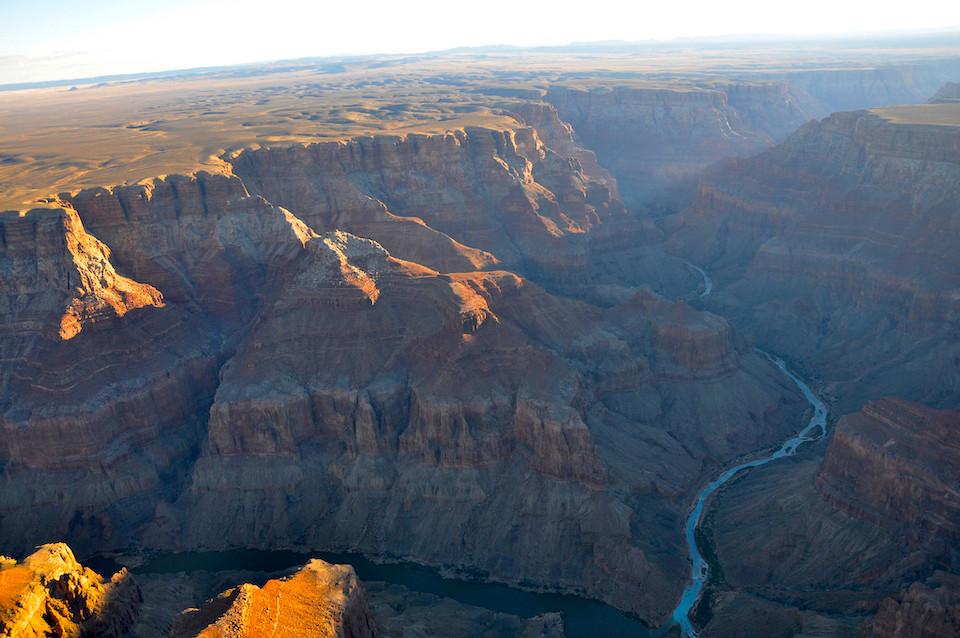
Conservationists are up in arms over a plan to build dams on the Little Colorado River (right side) upstream of Grand Canyon National Park/NPS file
A proposal to build four dams on the Little Colorado River just upstream of Grand Canyon National Park has gotten roundly panned by conservationists, who said the dams would alter water flows in the main Colorado River through the national park and affect the fishery.
Pumped Hydro Storage, LLC, of Phoenix, wants to construct the series of dams, with reservoirs, on the Little Colorado not far upstream from the river's confluence with the main Colorado.
The proposed Navajo Nation Salt Trail Canyon Pumped Storage Project would consist of the following: (1) a new 240-foot-high, 500-foot-long upper dam and reservoir; (2) a new 140-foot-high, 1,000-foot-long lower dam and reservoir; (3) six 250- megawatt, turbine-generator units, for a total installed capacity of 1,500 megawatts; (4) a new 20-mile-long, 500-kilovolt transmission line from the powerhouse to the existing Moenkopi switchyard; and (5) appurtenant facilities. The proposed project would have an average annual generation of 3,300 gigawatt-hours
The proposed Navajo Nation Little Colorado River Pumped Storage Project would consist of the following: (1) a new 200-foot-high, 3,200-foot-long upper dam and reservoir; (2) a new 150-foot-high, 1,000-foot-long lower dam and reservoir; (3) eight 400-megawatt, turbine-generator units, for a total installed capacity of 3,200 megawatts; (4) two new 22-mile-long, 500-kilovolt transmission lines from the powerhouse to an existing grid interconnection point; and (5) appurtenant facilities. The proposed project would have an average annual generation of 8,500 gigawatt-hours.
Earthjustice is representing Save the Colorado, the Grand Canyon Trust, the Sierra Club, Living Rivers, Waterkeeper Alliance, and WildEarth Guardians in the proceeding before the Federal Energy Regulatory Commission.
“Flooding one of the most stunning landscapes in America for a speculative profit makes no sense, whichever way you look at it,” said Michael Hiatt, staff attorney in Earthjustice’s Rocky Mountains office. “When a company proposes a project that would harm the Grand Canyon, the conservation community and the American people do not sit idly by. If Pumped Hydro Storage moves forward with these dams, it will face a coalition of voices who have defended the Grand Canyon for decades.”
The organizations claim that the dams and associated reservoirs would change the timing and flows of the Little Colorado River just before it reaches the Colorado River, which carved the iconic red rock switchbacks of the Grand Canyon over millennia. The dams would lower the temperature of the Little Colorado River, and eliminate its famed milky turquoise waters prized by rafters. The dam proposal faces significant legal hurdles, as it would destroy the primary spawning grounds for the humpback chub, an endangered fish protected by the Endangered Species Act.
“The warm waters of the Little Colorado River are vital to ensure the survival of the largest population of humpback chub remaining in the Colorado River,” said Jen Pelz, the wild rivers program director at WildEarth Guardians. “These dams are not welcome in one of the last truly living rivers in the Basin.”
“It is difficult to overstate what a truly bad idea this is,” said Sandy Bahr, chapter director for Sierra Club’s Grand Canyon Chapter. “It is as if they looked at a map of Arizona and said ‘where is the worst possible place to put these dams — a place where they would flood cultural sites, destroy habitat for the endangered humpback chub, and transform the Little Colorado waters?’ This proposal must be stopped.”
The conservationists claim the proposed dams would significantly alter the environment within Grand Canyon National Park by changing the flows, sediment, and temperature of the Colorado River.
“Proposing to dam the Grand Canyon's largest tributary ignores the lessons learned from the downstream damage caused when the gates of Glen Canyon Dam closed more than a half-century ago,” said Roger Clark, Grand Canyon Program director for the Grand Canyon Trust. “The humpback chub is endangered because of that dam, and this project would push the rare fish closer to extinction. The federal government has long recognized the Little Colorado River Gorge as a place of cultural significance, home to the Grand Canyon's Native peoples. The Federal Energy Regulatory Commission must consult all affected tribes.”
Proposals before the Federal Energy Regulatory Committee must pass a basic “fitness” test to determine whether a proposal deserves the time and resources of the agency. Conservation groups are asking regulators at FERC to deny Pumped Hydro Storage’s preliminary permit to explore damming the Little Colorado River on the grounds that it fails this basic “fitness” requirement, and because of the potential legal challenges on Endangered Species Act grounds and opposition from Native American Tribes.



Add comment